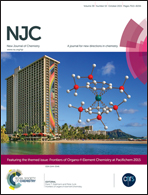Fabrication of TiO2/porous carbon nanofibers with superior visible photocatalytic activity
Abstract
TiO2/porous carbon nanofibers (TiO2/PCNFs) were prepared for visible photocatalysis for dye degradation. PCNFs were synthesized via an electrospinning technique, exhibiting a highly porous structure and large surface area. After hydrothermal treatment, TiO2 nanorods were deposited onto the PCNFs to obtain a TiO2/PCNFs heterostructure. By adjusting the amount of Ti source material, the amount of TiO2 nanorods could be easily controlled. Congo red (CR), methylene blue (MB), methyl orange (MO) and eosin red (ER) were adopted as the model dye molecules, and the adsorption and visible photocatalysis studies were carried out in depth. All of the TiO2/PCNFs exhibit an enhanced visible photocatalytic efficiency and good recyclability due to the large surface, improved visible light absorption and high separation efficiency of the photogenerated electron/hole. In particular, TiO2/PCNFs-4 possesses the ability to efficiently decolor MB solution even with a high concentration (120 mg L−1, 70 min), ascribed to the high adsorption capacity derived from the strong electrostatic interaction and structure match between TiO2/PCNFs-4 and MB. These TiO2/PCNF heterostructures exhibit the great potential for practical application to eliminate organic pollutants from wastewater.


 Please wait while we load your content...
Please wait while we load your content...